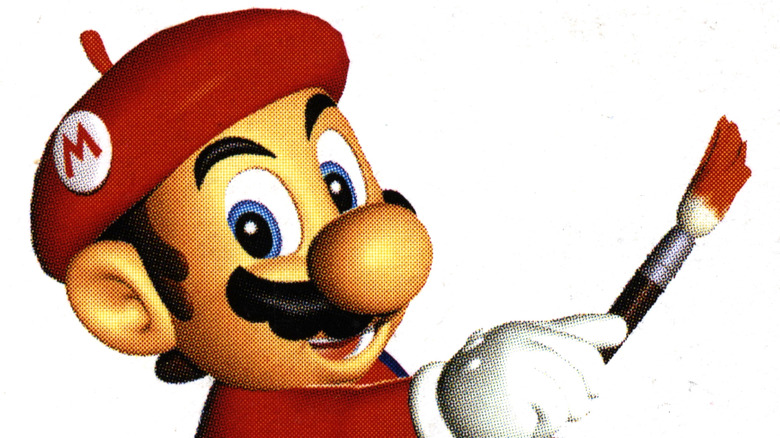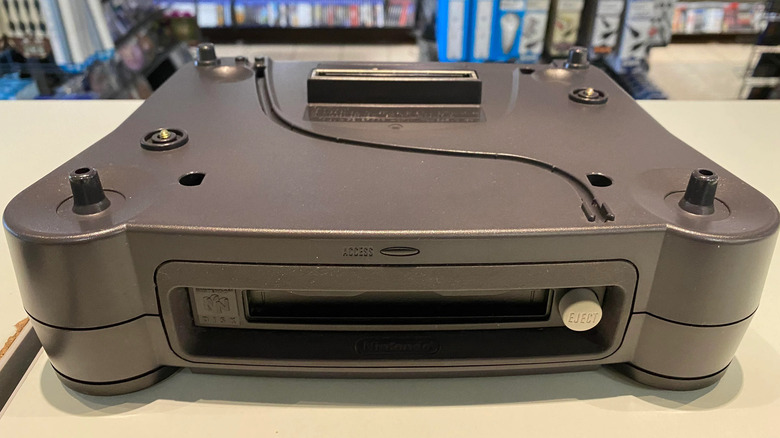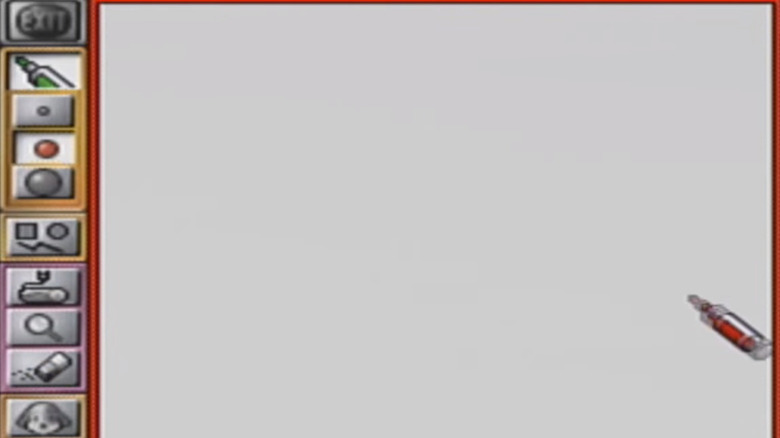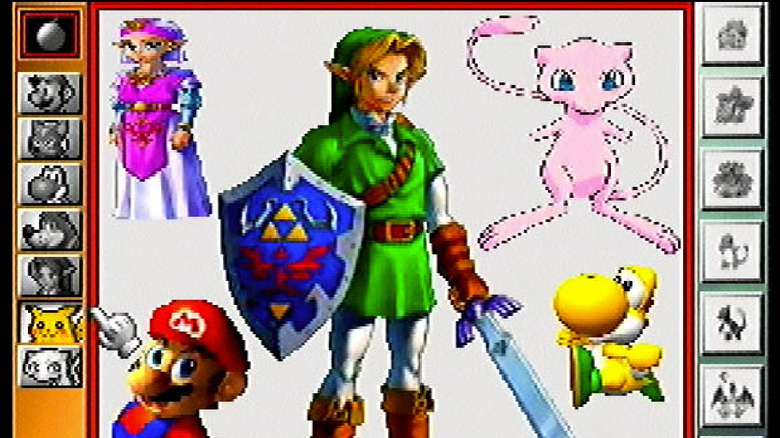The Sequel To Mario Paint That Was Exclusive To The Nintendo 64DD
The "Mario" games started as pure platformers, but Nintendo has featured the Italian plumber in a growing number of spin-offs over the decades. He appears in racing titles like "Mario Kart," sports entries such as "Mario Golf," brawlers like "Super Smash Bros." and even tactical, cover-based strategy shooters such as "Mario + Rabbids: Kingdom Battle." Far from new, this genre-bending trend started soon after the first "Mario" installments released in the '80s.
"Mario Paint," one of the most popular titles launched for the Super Nintendo, lets players create art and drawings with "Mario"-themed tools. "Mario" spin-offs have always possessed mere tangential ties to the mainline entries, but "Mario Paint" deviates more than usual. Less of a game and more of a photoshop-like program, it still found success, selling more than two million copies. Eventually, Nintendo developed "Mario Artist" for the Nintendo 64 as a successor, but a few factors doomed it to fail and it become one of the rarest Nintendo games ever — in large put due to its exclusivity to the Nintendo 64DD, a disc drive peripheral for the N64, that also failed commercially.
According to the creators of "Mario Artist," it only sold about 7,500 total units. Exclusive to Japan and the Nintendo 64DD, it hardly comes as a surprise that many fans have never heard of the title or its two follow-ups.
What was the Nintendo 64DD, anyway?
The Nintendo 64DD was not a console, it was a peripheral attachment one could buy as an add-on for the N64 (via VG Legacy). The DD stands for "disk drive," a reference to floppy disks. These disks boasted up to 64 MB of rewritable storage space — a fraction of today's standards, but good for the time — and were much more durable than the newly-popular CD-ROM. The main draws of the Nintendo 64DD for players were its online functionalities, which operated via the now-defunct Randnet (per Giant Bomb), and the potential for expansions to existing games like "F-Zero X."
According to Giant Bomb, Randnet was one of Nintendo's first forays into online gaming — for the "Mario Artist" games on the Nintendo 64DD, it allowed users to share their work via the internet. After hooking their N64 up to a modem, Randnet let players message each other (and even developers), browse the internet, listen to music, spectate and play games, and share their creations in titles like "Mario Artist."
As detailed by VG Legacy, Nintendo originally intended to launch the 64DD alongside the N64 console, but the manufacturer delayed its release by around three years until 1999. Even then, it only came out in Japan, and according to an IGN report from early 2001 — the same year Randnet was discontinued — it could only be bought via an annual mail-order subscription plan. The Nintendo 64DD ultimately failed, with Kotaku estimating that it sold only around 15,000 units in its short lifetime from 1999 to 2001.
Revolutionary but doomed to fail
Three games launched for the "Mario Artist" series on the Nintendo 64DD: "Mario Artist: Paint Studio," "Talent Studio," and "Polygon Studio." Though listed alongside the other entries, the "Communication Kit" functioned as an add-on that contained everything one needed to start sharing creations via Randnet.
"Paint Studio" serves as a spiritual successor to the Super Nintendo's "Mario Paint" with new game modes, creation tools, and presentations; it is essentially the same game, but upgraded for the N64. In "Talent Studio," players create, animate, and play games with custom-made characters. They can then use these custom assets in other "Mario Artist" entries. Closer to a basic game and 3D creation tool than a painting suite, "Polygon Studio" allows players to create custom 3D models and structures and play polygonal mini-games that, according to developer Goro Abe, inspired the "Wario Ware" series.
Creation-driven titles like "Mario Paint" and "Mario Artist" were rare on consoles at the time, which typically relied on controller input, so players needed a mouse attachment to play them at all. Though "Mario Paint" is simple enough to not require a mouse, "Mario Artist" is much more complex. Floppy disks were pricier to make than CDs too, and CDs were quickly becoming the standard. According to John Pickford, one of the "Mario Artist" creators, these factors, coupled with internal politics, turned this into one of Nintendo's biggest mistakes.
Paint Studio creators point to 'infighting' and company politics
John Pickford and his brother, Ste Pickford, have worked independently as game designers in the industry for decades as The Pickford Brothers. In 1995, John pitched a concept for a "Mario Paint" successor under partner development company Software Creations. According to the brothers' blog, they conceived "Mario Artist: Paint Studio" as a single game that let the user "mess around and play God" in "living 3D environments." In this original concept, players could not only make custom 3D models and art, they could also create custom sound and modify the AI behavior of the world's NPCs.
After the siblings finished the project and John said goodbye to Software Creations to start his own game company, Nintendo's R+D team went on to make the two "Mario Paint" sequels on its own. The brothers' blog blamed "political infighting" between the American and Japanese branches of Nintendo for the series' overall misfire, and said that after the Japanese team took control, they "ejected many of the ideas which had been accepted [enthusiastically] by the Americans ... throwing away loads of work."
Though the "Mario Artist" games and the Nintendo 64DD may have given players technically impressive creative capabilities, commercial failure made them a footnote in Nintendo's history.




